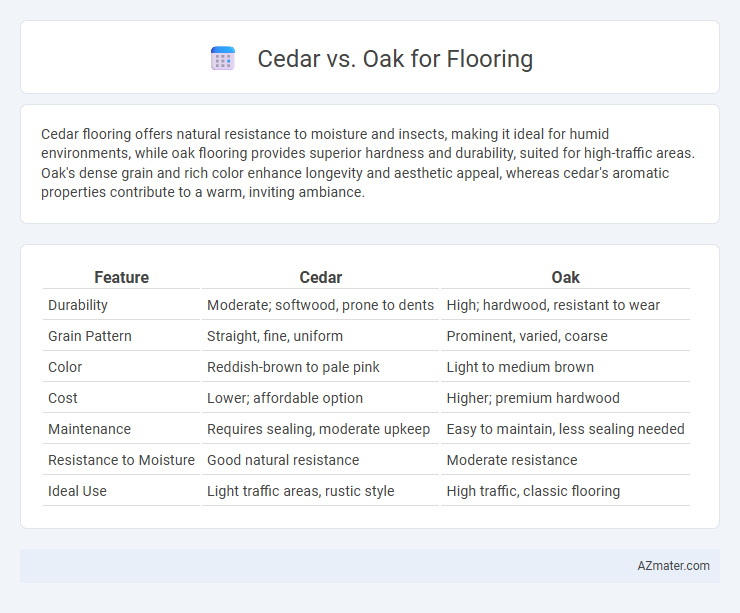Cedar flooring offers natural resistance to moisture and insects, making it ideal for humid environments, while oak flooring provides superior hardness and durability, suited for high-traffic areas. Oak's dense grain and rich color enhance longevity and aesthetic appeal, whereas cedar's aromatic properties contribute to a warm, inviting ambiance.
Table of Comparison
| Feature | Cedar | Oak |
|---|---|---|
| Durability | Moderate; softwood, prone to dents | High; hardwood, resistant to wear |
| Grain Pattern | Straight, fine, uniform | Prominent, varied, coarse |
| Color | Reddish-brown to pale pink | Light to medium brown |
| Cost | Lower; affordable option | Higher; premium hardwood |
| Maintenance | Requires sealing, moderate upkeep | Easy to maintain, less sealing needed |
| Resistance to Moisture | Good natural resistance | Moderate resistance |
| Ideal Use | Light traffic areas, rustic style | High traffic, classic flooring |
Cedar vs Oak: An Introduction to Flooring Choices
Cedar and oak offer distinct advantages as flooring materials, with cedar known for its natural resistance to moisture and decay, making it ideal for humid environments. Oak flooring provides exceptional durability and a classic aesthetic, favored for high-traffic areas due to its hardness and grain patterns. Choosing between cedar and oak depends on factors like desired durability, appearance, and environmental conditions.
Appearance and Grain: Comparing Cedar and Oak
Cedar flooring boasts a warm, reddish hue with a straight, fine grain that offers a rustic, natural look, while oak presents a more varied palette from light to medium brown with prominent, swirling grain patterns that add character and texture. Oak's grain is typically more pronounced and open, enhancing its ability to showcase stains and finishes, whereas cedar's subtle grain and softer texture provide a smoother, more uniform surface. Both woods are visually distinctive, making the choice between cedar and oak a matter of preference for either a classic, bold grain or a gentle, understated appearance.
Durability and Hardness: Which Wood Lasts Longer?
Oak flooring offers superior durability and hardness, ranking between 1290 and 1360 on the Janka hardness scale, making it highly resistant to dents and wear. Cedar, with a Janka hardness of around 350 to 900 depending on the species, is softer and more prone to scratches and dents over time. For long-lasting flooring that withstands heavy foot traffic, oak is the preferred choice due to its robust hardness and resilience.
Resistance to Moisture and Pests
Cedar flooring offers excellent resistance to moisture and natural oils that repel insects, making it highly resistant to pests and molding in damp environments. Oak flooring is denser and less porous, providing good moisture resistance but is more prone to termite damage if not properly treated. Selecting cedar is ideal for high-moisture areas due to its superior natural pest repellence, while oak requires additional sealing and maintenance for similar protection.
Maintenance Requirements for Cedar and Oak Floors
Cedar floors require regular sealing and occasional sanding due to their softer wood fibers, which make them more prone to dents and scratches compared to oak. Oak floors demand less frequent maintenance, primarily requiring periodic refinishing and cleaning because of their dense hardwood structure that resists wear and moisture better. Both types benefit from routine sweeping and avoiding excessive water exposure to maintain durability and appearance.
Environmental Impact and Sustainability
Cedar flooring offers a more sustainable option due to its faster growth rate and renewability compared to oak, which takes significantly longer to mature. Cedar's lower density results in reduced energy consumption during harvesting and processing, leading to a smaller carbon footprint. Oak, while durable and long-lasting, often requires more resource-intensive management practices, making cedar preferable for environmentally conscious flooring choices.
Cost Comparison: Cedar vs Oak Flooring
Cedar flooring generally costs between $4 to $7 per square foot, making it a more affordable option compared to oak, which ranges from $6 to $12 per square foot. Oak flooring's higher price reflects its greater durability and wide grain patterns favored for classic and high-traffic spaces. When considering long-term investment, oak tends to retain value better due to its toughness and resistance to wear.
Installation Considerations
Cedar flooring requires careful acclimation to avoid warping due to its high moisture content, while oak's dense grain structure allows for more straightforward installation with less risk of expansion or contraction. Oak floors provide excellent stability on various subfloor types, making them suitable for both nail-down and glue-down installation methods, whereas cedar often performs best with floating or nail-down options. Proper moisture barriers and subfloor preparation are critical for both woods to ensure longevity and prevent installation issues such as buckling or gaps.
Best Uses: Where Each Wood Excels
Cedar flooring excels in areas requiring natural resistance to moisture and insects, such as basements, closets, and cabins, due to its aromatic oils and durability. Oak flooring is best suited for high-traffic areas like living rooms, hallways, and commercial spaces because of its exceptional hardness and wear resistance. Both woods offer unique aesthetics, with cedar providing a warm reddish hue and oak delivering classic, versatile grains that complement various interior styles.
Final Verdict: Which Flooring is Right for You?
Cedar flooring offers a softer, warmer aesthetic with natural resistance to insects and decay, making it ideal for cozy, rustic interiors or moisture-prone areas. Oak provides superior hardness, durability, and a timeless grain pattern, suited for high-traffic spaces requiring long-lasting performance and easy maintenance. Choosing between cedar and oak depends on your priority for durability versus natural warmth, with oak favored for strength and longevity, while cedar excels in natural beauty and resistance to environmental factors.

Infographic: Cedar vs Oak for Flooring
 azmater.com
azmater.com